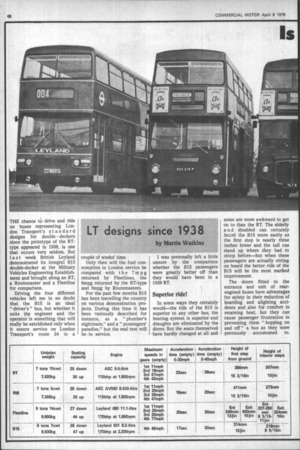LT designs since
Page 70

Page 71

If you've noticed an error in this article please click here to report it so we can fix it.
by Martin Watkins
THE chance to drive and ride on buses representing London Transport's standard designs for double deckers since the prototype of the RTtype appeared in 1938, is one that occurs very seldom. But last week British Leyland demonstrated its integral B15 double-decker at the Military Vehicles Engineering Establishment and brought along an RT, a Routemaster and a Fleetline for comparison.
Driving the four different vehicles left me in no doubt that the B15 is an ideal " driver's " bus, but whether it suits the engineer and the operator is something that will really be established only when it enters service on London Transport's route 24 in a couple of weeks' time.
Only then will the fuel consumption in London service be compared with the 7mpg returned by Fleetlines, the 8mpg returned by the RT-type and 9mpg by Routemasters.
For the past few months E15 has been travelling the country on various demonstration projects. During this time it has been variously described for instance, as a "plumber's nightmare," and a "passengers' paradise," but the real test will be in service. I was personally left a little unsure by the comparison whether the B15 passengers were greatly better off than they would have been in a 1938 RT.
Superior ride!
In some ways they certainly would—the ride of the B15 is superior to any other bus, the heating system is superior and draughts are eliminated by the doors. But the seats themselveS have hardly changed at all and some are more awkward to get on to than the RT. The elderly and disabled can certainly board the B15 more easily as the first step is nearly three inches lower and the tall can stand up where they had to stoop before—but when these passengers are actually sitting on board the better ride of the B15 will be the most marked improvement.
The doors fitted to the entrance and exit of rearengined buses have advantages for safety in their reduction of boarding and alighting accidents and also for comfort in retaining heat, but they can cause passenger frustration in preventing them "hopping on and off" a bus as they were previously accustomed to. These " impulse " rides can also lose the operators money, as not all short-distance riders are prepared to queue for a bus.
Inevitably, the low floor of the B15—and the centre exit and stairway — results in the downstairs seating layout being much more untidy than it was in the RT or Routemaster days.
Then regular parallel banks of seats filled the main body of the interior, with bench seats parallel to the vehicle sides positioned over the rear axle. In the B15 and the Fleetline the floor is raised, both surrounding the front wheel arches and the area surrounding the rear wheel arches. Only three seats are bolted straight on to the floor, the remainder being fixed to one or other of these platforms—these are all easy enough to get on to on the B15—but passengers on these raised seats, particularly those positioned parallel to the body sides, can be given some feeling of insecurity by being so far above the actual floor of the bus.
The positioning of the handrails in the lower saloon of the B15 is much better than on the Fleetline--a rid has been the subject of a great deal of human factors research engineering by British Leyland.
But the security of the hanks of parallel seats of the RT and RM cannot really be matched by the more open layout of the rear-engined vehicles. The seat backs and handrails of the front-engined RT and Routemaster always give the passenger and conductor something handy to hold on to if needed.
Driver comfort
The development of driver comfort through the four types of bus was extremely marked. Getting into the cab of the RT was difficult enough— especially from the outside step to the door sill. Then I had to negotiate the handbrake lever to get my feet into the well in which the pedals are positioned.
The driver's seat itself was particularly well-cushioned and comfortable—perhaps to compensate for the rough ride of the RT! This was the first preselect bus I had driven, but this type of control presented four difficulties once I got used to the gear-change pedal not being a clutch.
The most noticeable feature of the RT was the rough ride in the cab, especially as all bumps in the road seemed to be transmitted through the steering column to the steering wheel. I was favourably surprised by the lightness of the manual steering and the effectiveness of the air brakes on, what is basically a 1938 design.




























































































































